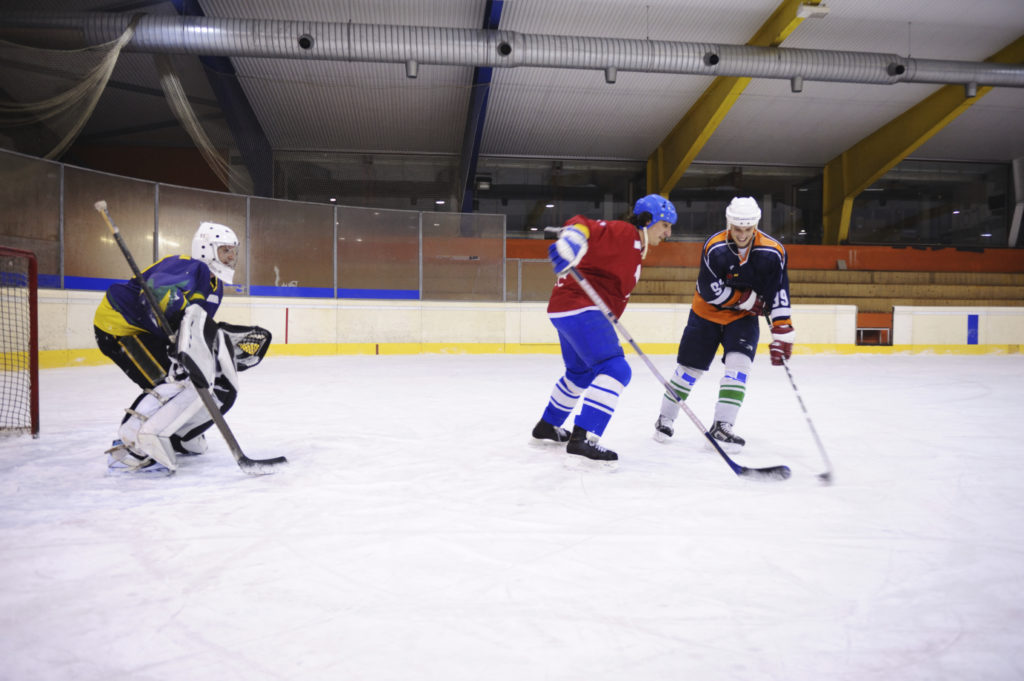THIS POST IS PART OF THE ULTIMATE GUIDE TO SPORTS MEDICINE
Ice hockey is a fast-paced sport that requires a combination of speed, power and teamwork. As hockey players race back and forth, crashing into the sides of the rink and each other it’s inevitable that injuries occur.
Common injuries
Concussions are the most common injuries seen in hockey. However, other common hockey injuries include knee and shoulder injuries. More specifically medial collateral ligament (MCL) injuries for knee injuries; acromioclavicular (AC) joint and clavicle fractures for shoulder injuries.
Symptoms of an MCL sprain include knee pain on the inside of the knee and sometimes a feeling of instability. This is particularly noticeable in hockey players as they push off the inside edge of their skate placing an inward stress on the knee.
Players with AC joint injuries will have pain over the top of the shoulder, pain with elevating the arm above shoulder level and in more severe injuries, deformity at the AC joint.
“Muscle strains around the hip are also common hockey injuries,” said Dr. Chris Bales, OrthoIndy sports medicine specialist. “Groin and hip flexor strains are commonly seen in hockey players due to the mechanics of the skating stride.”
A thorough history of the patient and a physical by a sports medicine specialist can diagnose most hockey injuries.
According to Dr. Bales, concussions typically result from a direct blow to the head. These often occur when a player has his head down and the opposing player hits him with his elbow or shoulder. Most concussions don’t result in a loss of consciousness. Symptoms may be vague but any player who suffers a blow to the head and complains of dizziness, headaches, nausea etc. needs to be evaluated for a concussion.
Shoulder injuries are often the result of a direct blow to the shoulder with another player, the boards or ice. Tenderness and sometimes deformity at the AC joint or clavicle will be present on exam. X-rays can be obtained to demonstrate a clavicle fracture or AC joint separation.
“A player with an MCL sprain often describes a history of contact to the outside of the knee or a fall to the ice and the knee collapsing inward,” said Dr. Bales. “Testing of stability of the MCL involves placing an inward force on the knee and feeling how much it ‘opens up’. This allows the physician to determine the grade of the sprain. An MRI can be obtained for more significant tears.”
Treatment
Depending on the seriousness of the injury and the treatment options the player can return to hockey anywhere between 24 hours and six weeks after injury. In very severe injuries, the athlete may not be able to return for the entire season. Most injuries can be treated with rest, ice and immobilization and do not require surgery.
Injury prevention
“Wearing appropriate protective equipment can substantially reduce the risk of injury,” said Dr. Bales. “Proper warm up, particularly stretching, can help prevent muscle strains of the hip. Sportsmanship and respect for fellow players can also reduce the probability of an injury occurring.”
Learn more about sports medicine treatment at OrthoIndy.
Schedule an appointment
Your well-being is important to us. Click the button below or call us to schedule an appointment with one of our orthopedic specialists. If your injury or condition is recent, you can walk right into one of our OrthoIndy Urgent Care locations for immediate care. For rehabilitation and physical therapy, no referral is needed to see one of our physical therapists.





